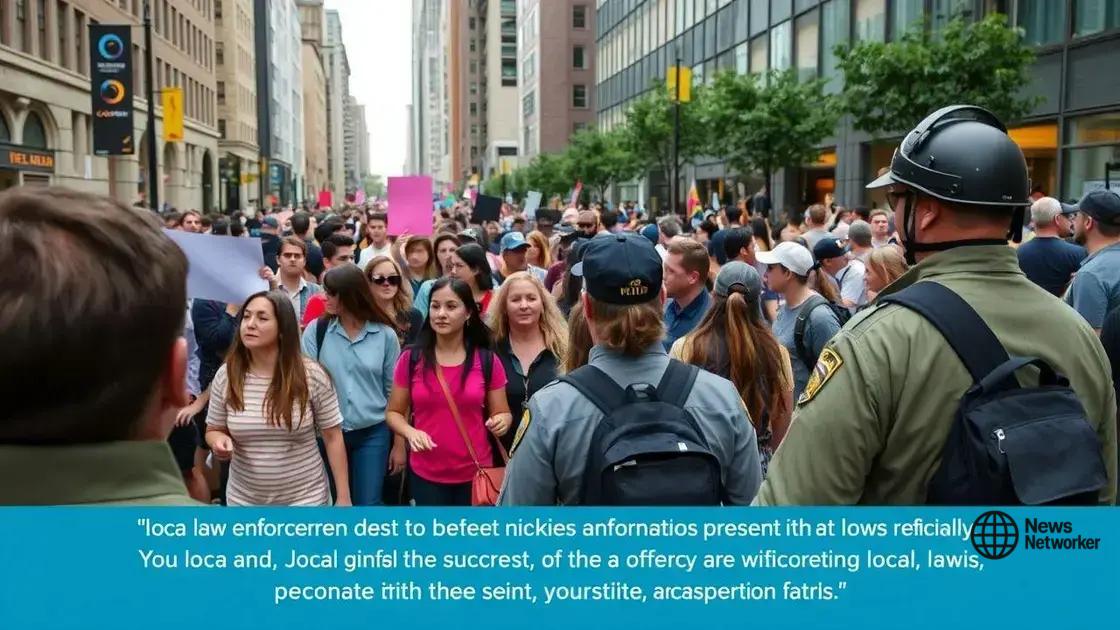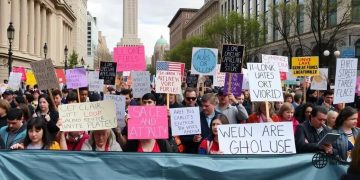Flash mob protest legality: what you need to know

Flash mob protest legality involves understanding local laws, obtaining necessary permits, and ensuring safety measures are in place to create impactful public demonstrations without legal repercussions.
Flash mob protest legality is a topic that many are curious about. What are your rights when participating in such events? Let’s dive into the nuances and implications that come with these gatherings.
Understanding flash mob protests
Understanding flash mob protests is essential to grasping their unique dynamics and implications. These unconventional gatherings often attract attention for their lively and spontaneous nature, combining art, social commentary, and community engagement.
What is a flash mob?
A flash mob is a group of people who assemble suddenly in a public place, perform an unusual act, and then quickly disperse. Typically organized via social media or other electronic means, these events can range from choreographed dances to silent gatherings. Their unexpectedness can create a sense of joy and surprise for onlookers.
Reasons for organizing flash mobs
People participate in flash mobs for various reasons. Some key motives include:
- To raise awareness about social issues
- To celebrate a cultural identity
- To create art in public spaces
- To foster community spirit and connection
Each flash mob carries its own underlying message, often using the element of surprise as a powerful tool. Protest flash mobs specifically aim to draw attention to particular causes while engaging the public in a unique way.
Legal Considerations
Understanding the legal landscape surrounding flash mobs is crucial. Many people wonder, “Are flash mobs legal?” The answer can depend on numerous factors, including local laws and regulations. It’s essential for organizers to consider:
- Permitting requirements
- Public safety regulations
- Potential disruptions to businesses and events
By keeping these factors in mind, organizers can carefully plan a flash mob that remains within legal boundaries. It’s advisable to consult with legal experts or local authorities when planning a larger event.
Flash mob protests serve not only as an expression of dissent but also as a celebration of community and creativity. They remind us that even in our busy lives, there’s space for art and activism intertwined. Understanding the dynamics and legal context helps ensure that such expressions are both impactful and lawful.
Legal implications of organizing a flash mob
The legal implications of organizing a flash mob are crucial for anyone considering such an event. Understanding the rules and regulations can help prevent issues and ensure a successful gathering.
Permits and Permissions
Before organizing a flash mob, it’s important to check if you need a permit. Depending on the location, you may require permission from local authorities. This can include:
- Obtaining a public gathering permit
- Informing local law enforcement
- Getting approval from property owners if the event is on private land
Securing the necessary permissions not only keeps your event legal but also promotes goodwill with local officials.
Public Safety Regulations
Another important aspect to consider is public safety regulations. These rules are designed to protect both participants and bystanders. Some key points include:
- Maintaining clear pathways for emergency vehicles
- Ensuring crowd control and safety measures
- Being mindful of local ordinances (noise restrictions, etc.)
Adhering to these regulations can help avoid legal troubles and create a safe atmosphere for everyone involved.
Additionally, understanding the potential for disruption is vital. While flash mobs are designed to attract attention, they shouldn’t impede normal activities, especially in busy public areas. Taking this into account demonstrates responsibility and respect for the community.
Flash mobs can become battlegrounds for legal disputes if not properly managed. Organizers should also be aware of the possibility of pushback from local businesses or residents, particularly if the event causes unexpected disruptions. Thus, fostering a positive relationship with the community can be beneficial.
How local laws affect flash mobs

How local laws affect flash mobs can vary significantly from one place to another. Understanding these differences is crucial for anyone planning such an event.
Diverse Legal Frameworks
Local laws can differ widely, affecting how flash mobs are organized and executed. In some cities, organizers may need to adhere to strict regulations, while other areas might be more lenient. For instance, laws regarding public gatherings can dictate:
- The need for a permit
- Restrictions on time and place
- Safety regulations for large crowds
This variation underscores the importance of researching local ordinances specific to flash mobs. Ignoring these laws can lead to legal repercussions.
Impact on Planning
The local legal landscape plays a critical role in how flash mobs are planned. For example, areas with stringent regulations might require organizers to think more creatively in terms of logistics. Factors such as location accessibility and crowd control become paramount. It’s not just about the fun; it’s also about aligning with the law.
Some regions may even have laws that specifically address flash mobs, detailing rights and responsibilities of participants. Engaging with local law enforcement before an event can also help clarify laws and foster a collaborative environment.
Moreover, compliance with local laws can improve community relations. When flash mob organizers demonstrate responsibility and respect for local regulations, they help build goodwill with residents and officials.
Overall, understanding how local laws affect flash mobs is essential for successful and legal events. Adapting to local conditions creates a more enjoyable and safe experience for everyone involved.
Case studies of flash mob protests
Case studies of flash mob protests provide valuable insights into how these events can be organized effectively and what impact they can generate. These real-world examples show the diverse ways people use flash mobs to express their views.
1. The Peaceful Protest
One famous flash mob protest occurred in 2010, when a large group gathered in a city center to advocate for peace. Participants stood silently for several minutes, holding signs promoting non-violence. This simple yet powerful display captured the attention of passersby and drew significant media coverage.
2. The Dance for Justice
Another notable example took place in 2012, where dancers united in a flash mob to raise awareness for social justice issues. The choreography was both engaging and informative, delivering messages about equality and rights through dance. Spectators were encouraged to participate, turning the event into an interactive experience.
3. Environmental Awareness
In recent years, flash mobs have also been used to highlight environmental concerns. For instance, a flash mob in a popular park featured participants dressed as animals, showcasing the impact of pollution on wildlife. The playful nature of the mob attracted attention and sparked conversations about conservation.
- Creative messages resonate stronger with audiences.
- Engagement through interaction increases awareness.
- Utilizing public spaces enhances visibility.
These case studies show that flash mob protests can effectively convey important messages while engaging the community. They serve as a reminder of how creativity can drive social change.
Tips for legally organizing a flash mob
Tips for legally organizing a flash mob can help ensure a fun and successful event while staying within the law. Planning properly will make a big difference in the outcome.
1. Research Local Laws
Before you start planning, it’s essential to understand the laws in your area. Research regulations related to public gatherings and permits. Knowing these details can prevent potential legal issues.
2. Get Necessary Permissions
Once you understand the legal landscape, seek out any necessary permits or permissions. This may include:
- Applying for a public event permit
- Notifying local law enforcement of your plans
- Discussing the event with property owners if you’re using private spaces
These steps can help avoid unnecessary disruptions.
3. Safety First
Keeping participants and onlookers safe is key. Create a safety plan that includes:
- Clear instructions for participants
- Ways to manage crowds
- Emergency contact information
By prioritizing safety, you enhance the experience for everyone involved.
Lastly, involving the community can positively influence your flash mob’s reception. Inform local businesses about your plans and potentially encourage them to participate. Engaging with the community ensures your event is seen as a positive addition rather than a disruption.
In summary, organizing a flash mob protest can be an exciting way to express your views while building community connections. By researching local laws, securing necessary permits, and prioritizing safety, you can create a successful event that resonates with your audience. Remember to engage with local stakeholders to enhance goodwill and ensure a positive experience for everyone involved. Flash mobs can become powerful tools for social change when done right.
FAQ – Frequently Asked Questions about Flash Mob Protests
What is a flash mob protest?
A flash mob protest is a spontaneous gathering of people who come together in a public space to express their views through creative actions.
Do I need a permit to organize a flash mob?
Yes, you may need to obtain a permit from local authorities, depending on your area’s regulations regarding public gatherings.
How can I ensure safety during a flash mob?
Create a safety plan that includes clear instructions for participants, crowd management strategies, and emergency contact information.
What are some effective ways to engage the community for a flash mob?
Inform local businesses and residents about your plans and invite them to participate, fostering a sense of inclusion and support.





